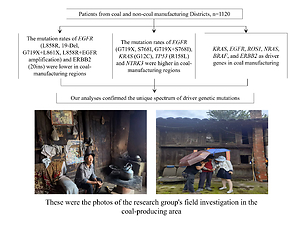Current issue
Archive
Manuscripts accepted
About the Journal
Editorial office
Editorial board
Section Editors
Abstracting and indexing
Subscription
Contact
Ethical standards and procedures
Most read articles
Instructions for authors
Article Processing Charge (APC)
Regulations of paying article processing charge (APC)
ONCOLOGY / CLINICAL RESEARCH
Unique spectrum of driver gene mutations in patients with non-small cell lung carcinoma from coal-manufacturing districts in Southwest China
1
Clinical Laboratory, Qujing First People’s Hospital, Qujing, China
2
School of Basic Medical Sciences, Qujing Medical College, Qujing, China
3
Department of Ophthalmology, Qujing Second People’s Hospital, Qujing, China
4
Department of Respiratory Medicine, Qujing First People’s Hospital, Qujing, China
5
Department of Medical Administration, Qujing First People’s Hospital, Qujing, China
6
Department of Oncology, Qujing First People’s Hospital, Qujing, China
7
Department of Thoracic Surgery, Qujing First People’s Hospital, Qujing, China
8
Department of Traditional Chinese Medicine, Qujing First People’s Hospital, Qujing, China
9
Department of Pathology, Qujing First People’s Hospital, Qujing, China
10
Department of Blood Transfusion, Qujing First People’s Hospital, Qujing, China
11
Beijing Life Healthcare Medical Laboratory, China
Submission date: 2022-09-06
Final revision date: 2022-11-18
Acceptance date: 2022-12-09
Online publication date: 2022-12-24
KEYWORDS
non-small-cell lung cancerEGFR/KRAS/TP53/ERBB2/NTRK3mutation spectrumcoal-manufacturing districtsEastern Yunnan
TOPICS
ABSTRACT
Introduction:
The coal-manufacturing districts in the Eastern Yunnan province of Southwest China have the highest rates of occurrence and death from lung tumors. Unique clinical characteristics of non-small cell lung cancer (NSCLC) in patients from these regions were previously reported without a clear understanding of the etiology and molecular characteristics. We aim to identify the unique driver gene mutation spectrum.
Material and methods:
Samples from 1120 NSCLC patients from Eastern Yunnan were gathered for next-generation sequencing. Seventeen gene targets were sequenced. We compared individuals’ medical and genetic features from the coal- and non-coal-manufacturing zones.
Results:
The mutation rates of EGFR (L858R, 19-Del, G719X+L861X, L858R+EGFR amplification) and ERBB2 (20ins) were low in patients from coal-manufacturing regions. Interestingly, EGFR (G719X, S768I, G719X+S768I), KRAS (G12C), TP53 (R158L), and NTRK3 demonstrated a much higher mutation frequency. Furthermore, EGFR compound mutations were linked with the patient’s job and TNM staging IIIb-IV. The OncodriverCLUST algorithm authenticated 6 genes (KRAS, EGFR, ROS1, NRAS, BRAF, and ERBB2) as driver genes in patients from coal-manufacturing regions. EGFR with KRAS, BRAF, RET, and TP53 with ALK and KRAS were mutually exclusive. Mutations in the TP53 signaling pathways were the most common in NSCLC patients from the coal-producing districts.
Conclusions:
Our analyses confirmed the unique spectrum of driver genetic mutations and emphasized the potential of future targeted therapy in NSCLC patients from the coal-manufacturing districts of Eastern Yunnan. Our data broaden the view of NSCLC pathogenesis and its relationship with the environmental conditions in coal-producing regions.
The coal-manufacturing districts in the Eastern Yunnan province of Southwest China have the highest rates of occurrence and death from lung tumors. Unique clinical characteristics of non-small cell lung cancer (NSCLC) in patients from these regions were previously reported without a clear understanding of the etiology and molecular characteristics. We aim to identify the unique driver gene mutation spectrum.
Material and methods:
Samples from 1120 NSCLC patients from Eastern Yunnan were gathered for next-generation sequencing. Seventeen gene targets were sequenced. We compared individuals’ medical and genetic features from the coal- and non-coal-manufacturing zones.
Results:
The mutation rates of EGFR (L858R, 19-Del, G719X+L861X, L858R+EGFR amplification) and ERBB2 (20ins) were low in patients from coal-manufacturing regions. Interestingly, EGFR (G719X, S768I, G719X+S768I), KRAS (G12C), TP53 (R158L), and NTRK3 demonstrated a much higher mutation frequency. Furthermore, EGFR compound mutations were linked with the patient’s job and TNM staging IIIb-IV. The OncodriverCLUST algorithm authenticated 6 genes (KRAS, EGFR, ROS1, NRAS, BRAF, and ERBB2) as driver genes in patients from coal-manufacturing regions. EGFR with KRAS, BRAF, RET, and TP53 with ALK and KRAS were mutually exclusive. Mutations in the TP53 signaling pathways were the most common in NSCLC patients from the coal-producing districts.
Conclusions:
Our analyses confirmed the unique spectrum of driver genetic mutations and emphasized the potential of future targeted therapy in NSCLC patients from the coal-manufacturing districts of Eastern Yunnan. Our data broaden the view of NSCLC pathogenesis and its relationship with the environmental conditions in coal-producing regions.
We process personal data collected when visiting the website. The function of obtaining information about users and their behavior is carried out by voluntarily entered information in forms and saving cookies in end devices. Data, including cookies, are used to provide services, improve the user experience and to analyze the traffic in accordance with the Privacy policy. Data are also collected and processed by Google Analytics tool (more).
You can change cookies settings in your browser. Restricted use of cookies in the browser configuration may affect some functionalities of the website.
You can change cookies settings in your browser. Restricted use of cookies in the browser configuration may affect some functionalities of the website.



